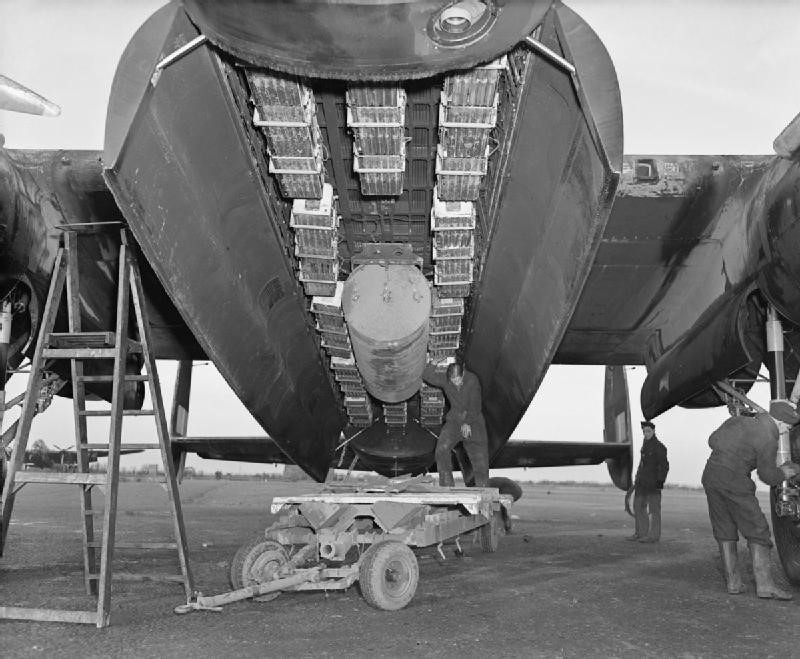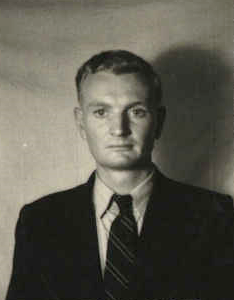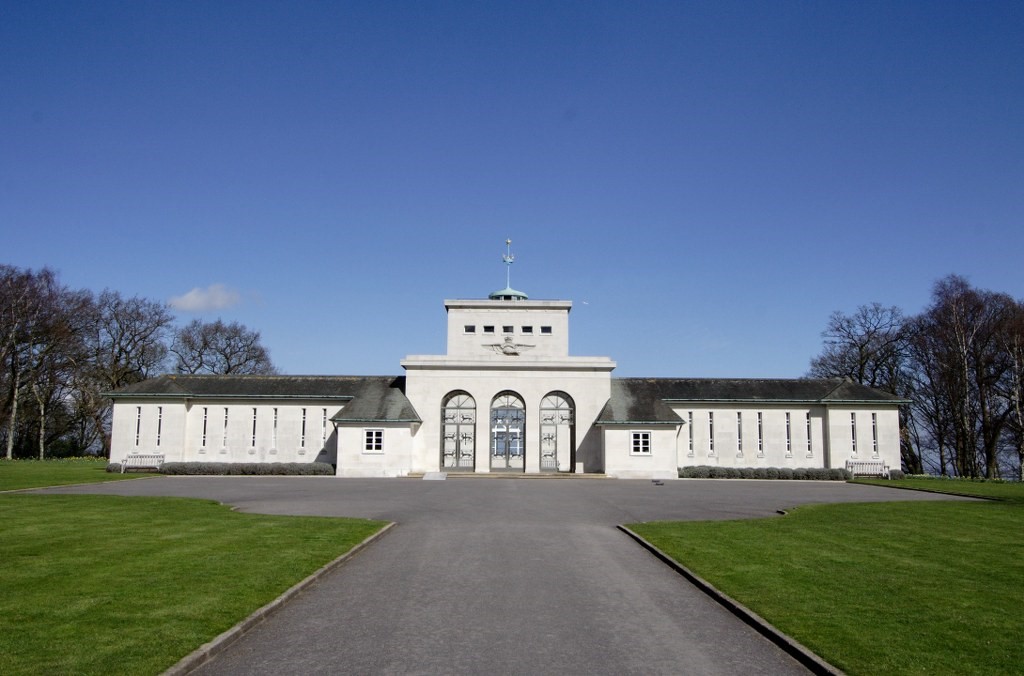Pilot Officer Ronald Firth Culliford, the son of Norman John Smith Culliford and Ruth Minnia Culliford (nee Robinson) was born at Miles in Queensland on 7th April 1922. He was educated at the Toowoomba Grammar School. He applied for aircrew training in the Royal Australian Air Force. He was enrolled in the Reserve of the R.A.A.F. on 7th June 1941 after swearing an oath of allegiance. At the time of his enrolment he was a student residing at “Craigveachon”, Rangeville, Toowoomba. At the age of 19 years and 9 months he was enlisted into the Citizen Air Force of the R.A.A.F. at No. 3 Recruiting Centre in Brisbane on 30th January 1942 after giving an undertaking that he would serve for the duration of the war and an additional twelve months. His physical description at the time of his enlistment was that he was 5 feet 10 inches in height and weighed 147 pounds. He had a fair complexion, blue eyes and yellow hair. He stated that he was of the Presbyterian religion. He gave his next of kin as his mother, Mrs Ruth Minnia Culliford, residing at Rangeville in Toowoomba. He also nominated Miss J.R. Culliford, residing at 91 Lefave Terrace, Adelaide, South Australia as a person to be notified in event of injury or death.
Pilot Officer Ronald Culliford was allotted the service number of 425129 and he joined No. 3 Initial Training School at Sandgate in Queensland on 31st January 1942 to learn the basics of military discipline. He was selected to undertake a fourteen week course of instruction to prepare him for employment as a Pilot. He joined No. 5 Elementary Flying Training School at Narromine in New South Wales on 25th June 1942 where he underwent a twelve week course of instruction on basic single-engined training aircraft. He joined No. 2 Embarkation Depot at Bradfield Park in Sydney on 17th September 1942 to prepare for movement overseas to Canada where he continued his training. He embarked from Sydney in New South Wales on 6th October 1942 and disembarked in Canada on 24th October 1942. After arriving in Canada he joined No. 2 Manning Depot at Brandon in Manitoba. He joined No. 15 Service Flying Training School at Claresholm in Alberta on 7th November 1942 where he underwent instruction on single and multi-engined aircraft. He joined No. 1 “Y” Depot at Halifax in Nova Scotia on 16th February 1943 for movement to England on attachment to the Royal Air Force. He qualified as a pilot and was awarded the Flying Qualification Badge and promoted to the rank of Temporary Sergeant on 5th March 1943. He joined the Royal Air Force Training Pool on 27th March 1943 and on the following day he embarked for England. He disembarked in England on 4th April 1943 and on the following day he joined No. 11 Personnel Despatch & Reception Centre at Bournemouth.
Pilot Officer Ronald Culliford joined No. 15 (Pilot) Advanced Flying Unit at Royal Air Force Station Leconfield on 8th June and No. 18 (Pilot) Advanced Flying Unit at Royal Air Force Station Lawford on 27th July 1943. He was promoted to the rank of Temporary Flight Sergeant on 5th September 1943. He joined No. 26 Operational Training Unit at Royal Air Force Station Wymeswold on 10th September 1943 where he trained for night bombing on Vickers Wellington aircraft. Pilot Officer Ronald Culliford joined No. 51 Base at Royal Air Force Station Swinderby on 15th December 1943. He was appointed to the commissioned rank of Pilot Officer on 21st February 1944. He joined No. 57 Squadron Royal Air Force at Royal Air Force Station East Kirkby for operational duties on 14th April 1944. Pilot Officer Ronald Firth Culliford was the Second Pilot and crew member of a No. 57 Squadron Royal Air Force Lancaster III ND 475 that departed Royal Air Force Station, East Kirkby, Lincolnshire, England, to attack an enemy target in France. The aircraft crashed at Whittlesey, Cambridgeshire, England, on 19th April 1944 at 1.00 am upon returning from a successful operation against an enemy target in France. His mother was notified by telegram on 25th April 1944 that he had lost his life in the crash.
The Officer Commanding No. 57 Squadron wrote the following letter to his mother on 23rd April 1944:
Dear Mrs Culliford, It is with profound regret that I now write to confirm the cable you will have received from the Air Ministry informing you that your son, Pilot Officer Ronald F. Culliford, is missing presumed killed following an aircraft accident in which he was involved on 19th April 1944. Your son had only recently arrived on the Squadron and was making his first operational flight as Second Pilot in an aircraft detailed to take part in a raid against an enemy target in France. The Captain of the aircraft was Pilot Officer A.E. Oberg, an excellent and experienced pilot in whom I had every confidence. The aircraft had successfully attacked the target and was on its return flight when for some reason which it has not been possible to determine, the machine crashed near a small village in Cambridgeshire.
I have withheld writing this letter to you until I received the report of the Squadron representatives who visited the scene of the accident as I know you would wish me to convey to you as much information as possible concerning this distressing incident. I feel it is my painful but rightful duty to tell you that the aircraft was totally destroyed on impact with the ground and although an exhaustive search has been made, only one member of the crew was found. He was the Air Gunner, Sergeant J.F. Willis. The crash was extremely severe although from this perhaps may be gained some little consolation in the knowledge that they died instantly and suffered no pain. Although your son had only just arrived on the Squadron and I had not had the opportunity of knowing him intimately, I had nevertheless formed the opinion from his record of service that he had all the qualities which would have made him an excellent operational pilot and his loss is a sad blow.
The aircraft dived vertically into the ground at high speed and was completely destroyed by impact and fire. There was some evidence of enemy intruder action in the vicinity before and after the crash. Only one member of the aircraft’s crew was able to be identified. A subsequent investigation found that it was not known whether the aircraft crash was due to enemy action, technical defect, or error of judgement on part of the pilot. A plaque was erected in the Cambridge Royal Air Force Regional Cemetery to the memory of Ronald Culliford and the other members of his crew. He has no known grave therefore his name is commemorated on the Runnymede Memorial for the Missing in the United Kingdom.
Ronald Culliford’s name is commemorated on Panel No. 121 at the Australian War Memorial in Canberra and locally on the Toowoomba Grammar School World War 2 Honour Board.

By Clarke (Plt Off), Royal Air Force Photographer – Photograph CH 18371 from the Imperial War Museums, Public Domain.
A 57 Squadron Lancaster with area bombing load of a 4000-pound blast bomb and incendiary bombs.
Toowoomba Grammar School archive records show that he enrolled as a day student on 1st February 1938 and he left the School on 5th December 1941. His parent was shown as Norman John Smith Culliford, Grazier, Toowoomba. He passed 9 Junior subjects and 6 subjects in Senior. He served as a Lieutenant in School Cadets and was a prefect in 1941. He participated in Grade cricket whilst a student.
The following obituary was published in the School Magazine in November 1944:
The following tribute by a life-long friend is paid to the memory of Pilot Officer Ronald Firth Culliford, son of Mrs R.M. Culliford, “Craigveachon”, and the late Mr N. Culliford, whose death has been confirmed after he had been reported missing as a result of a ‘plane crash in Cambridgeshire when returning from operations’. Born at Miles on 7th April 1922, Pilot Officer Culliford was the second son of Mr and Mrs Norman J. Culliford, of Dulacca Station, and lived there with his parents until 1937, when Mr Culliford purchased “Craigveachon”, Toowoomba, and Ronald became a pupil of the School, where he obtained excellent passes in both his Junior and Senior examinations. He was Prefect, and played in the First XV and the School Second XI. He also held a commission in the School Cadet Corps. When the R.A.A.F. recruiting train visited Toowoomba he was amongst the successful candidates, although only 18, and then began his training with the R.A.A.F. With other trainees he left for Canada, and subsequently to England. Letters received by his mother speak of the high regard in which he was held, and the following extract comes from a letter received from Flying Officer Baile, Surrey, England: “How sorry we were when Ron, our skipper and pal, failed to return. He was a great pilot, a perfect gentleman, always a wizard in the air – our skipper and, what is more, our pal. Although he was one of the youngest in the crew he fathered us and turned us out an A1 crew. Throughout our training we did not have one mishap with him. He was always so cool and careful, and his determination and keenness were an inspiration to us all. We shall carry his memory with us always.”
In another letter Flying Officer Horsman, Fence House, Durham, England, writes: “We first met Ron in August last year and liked him at once. We have been together since then and got to know him very well, and knowing him were happy to fly with him. As our skipper he had done a very great share in the training of an aircrew, and, even though he himself can no longer carry the war to the enemy, we are ready, thanks in no small way to him, to carry on for him. He was a steady pilot who never panicked or attempted anything beyond the normal risks of flying. He never had an accident, a rare thing in training command. As a skipper he set an excellent example to his crew, and we never found his judgement at fault. An ideal captain of aircraft, we never expected it would be his first and last operational trip. Ron has joined a splendid crowd, some of the glorious heroes of an ancient yesterday. I am proud to have flown with him and proud to have known him and to have been his friend. I only wish we could have fought together until the end. I thank you for letting him come.”




